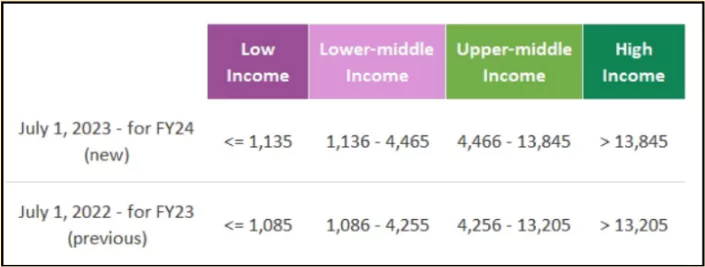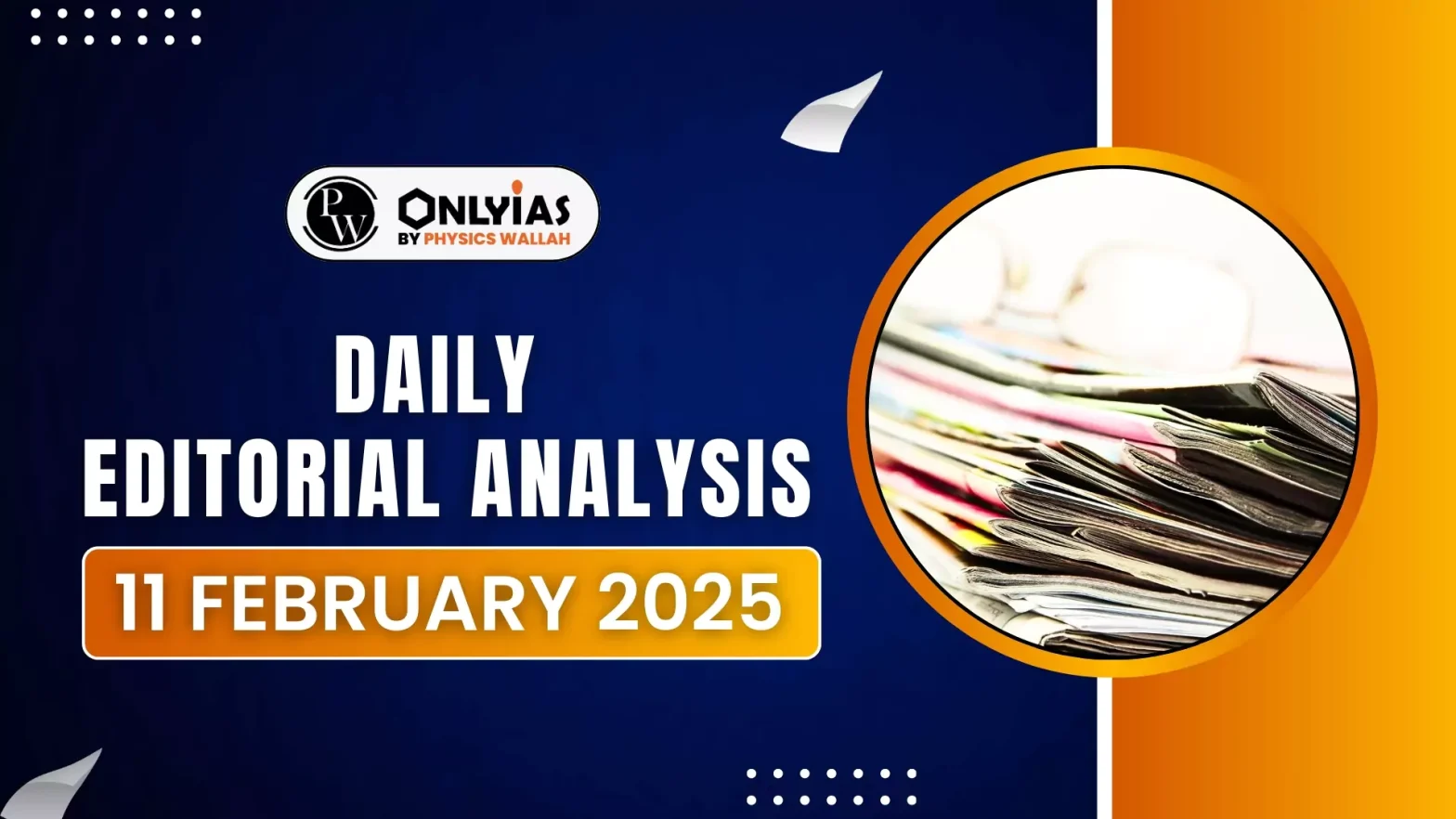India aspires to be a ‘Viksit Bharat’ by 2047; ; 100 years after independence. However, Historically, most nations have managed to move only one income bracket higher over the past 80 years. The question is whether India can defy the historical trends.
World Bank Classification of Economies
- The World Bank annually classifies economies into four income groups: low, lower-middle, upper-middle, and high income. This classification, updated each July 1, relies on the Gross National Income (GNI) per capita of the previous calendar year.
- For the fiscal year 2024, the income classifications are as follows;
- Low-Income: With per capita equal or less than $1,135
- Example: Congo, Afghanistan
- Lower-Middle Income: With per capita income between $1,136 to $4,465
- Upper-Middle Income: With per capita income between $4,466 to $13,845
- High-Income: With per capita income equal or more than $13,846
- USA, Japan, Germany
- 58 countries are high income countries and they are mostly North American (USA, Canada), European and some east Asian (like Japan, South Korea) countries.

Enroll now for UPSC Online Course
India’s Current Status
- Where Does India Stand?: India is currently classified as a “lower-middle income” nation. While its growth is consistent, it is still insufficient to reach high-income status.
- What Does Data State?: Historically, most nations have managed to move only one income bracket higher over the past 80 years.
- Understanding Through Example: For example, although India aims to become a high-income country, data shows that most countries can only jump one level. This suggests that India has a higher probability of becoming an upper-middle-income country rather than a high-income nation.
Lessons for India
- Which Countries Became Rich?: However, only four nations have successfully transitioned or jumped two categories to reach high-income status. India can draw lessons from these countries to achieve its goal of becoming a “Viksit Bharat” (developed India) by 2047.
- Japan: After the end of World War II, Japan was in ruins. However, through advancements in technology and a focus on exports, it managed to become a high-income country.
- South Korea: In the 1950s, South Korea was a low-income country and faced a dictatorial rule shortly after its independence. Despite these challenges, South Korea experienced rapid industrialization.
- Unlike democracies, where land acquisition and development are subject to lengthy processes, authoritarian regimes can sometimes expedite these processes.
- Taiwan: A small country, Taiwan successfully transitioned into a high-income nation. It built strong domestic industries, particularly in semiconductors and chip manufacturing, making it a global leader in technology.
- Singapore: Singapore, starting under a dictatorial regime, transformed into a global financial hub. The efficiency and stability provided by its government played a key role in its economic success.
Challenge of Middle Income Trap
- Middle Income Trap: Many countries face the “middle-income trap,” where they have achieved a certain level of economic development but remain stuck in the upper-middle-income bracket without transitioning to high-income status.
- China’s Example: China, Mexico, Turkey are currently an upper-middle-income country and face the challenge of moving past this stage.
- Reason: Several factors contribute to this phenomenon:
- Rising Labor Costs: As economies develop, wages increase, which diminishes their competitive edge in labor-intensive industries. This makes it challenging for these countries to compete with low-income countries in manufacturing exports.
- Lack of Innovation: Middle-income countries often struggle to transition from growth driven by factor accumulation (such as labor and capital) to growth driven by innovation.
- Without significant investment in research and development, education, and technology, these countries find it difficult to move up the value chain.
- Limited Industrial Diversification: Reliance on one or two industries can hinder economic resilience. Diversification into higher value-added sectors is essential for sustained growth, but many countries face challenges in achieving this.
- Weak Institutions and Governance: Poor governance, corruption, and weak institutions can impede economic progress by discouraging investment and stifling entrepreneurial activities.
- Demographic Challenges: Aging populations can lead to a shrinking workforce, reducing economic dynamism and increasing the burden on social welfare systems.
Check Out UPSC CSE Books From PW Store
Growth Models – What Works?
- Washington Consensus: According to the IMF and the World Bank, the Washington Consensus advocates for promoting free markets, privatization, and free trade as key factors for long-term economic growth.
- Failure or Success?: While this model has led to increases in per capita income, it has not consistently resulted in countries reaching high-income status. The model helps in boosting economic growth in the short run, but it has not proven sufficient for creating lasting wealth at the national level.
- Inclusive Institutions: Economists Daron Acemoglu and James A. Robinson argue that strong institutions are crucial for long-term development. They propose that establishing inclusive institutions—such as democracy, the rule of law, and an independent judiciary—helps a nation grow.
- Failure or Success?: However, examples like China and the early years of South Korea (before 1988, when it was under a dictatorship) show that countries can grow without inclusive institutions in the initial stages.
- While this model suggests that inclusive institutions are beneficial, it doesn’t always account for the rapid development seen in countries with non-democratic systems.
- Economic Nationalism: This model focuses on strategically protecting nascent industries until they become competitive enough to succeed on their own. It encourages protecting industries from foreign competition, promoting domestic innovation, and strategically importing technology to support development. This approach includes developing export champions and fostering domestic competition.
- Best Model: By nurturing homegrown industries and securing competitive advantages, countries can transition to high-income status over time. Countries like China and Japan followed this model.
Why Has India Lagged Behind?
- Weak Competition (Pre-1991 Era): Before the 1991 economic reforms, Indian industries were highly protected from foreign competition. While this protection shielded local industries, it also led to a lack of competition, which stifled innovation and efficiency. The private sector did not grow at the pace needed to drive economic development, resulting in low levels of innovation.
- Poor Execution of Export Zones: While India promoted exports through the creation of Special Economic Zones (SEZs), the implementation of these zones was inefficient. The poor execution and management of SEZs meant that India could not fully capitalize on the potential of these export hubs.
- Competition Between Governments: Unlike in China, where local governments were empowered to compete and innovate, India followed a top-down approach where local governments had limited authority. This lack of local empowerment hindered the development of regional economies and slowed overall growth.
- No Culling of Inefficient Businesses: In India, there was no process to phase out inefficient or underperforming businesses. Without an effective mechanism for removing or restructuring weak businesses, the economy was burdened by non-competitive sectors.
- Weak Industrial Protection and Poor Execution: Industrial protection measures in India were weak, and their execution was inconsistent. This lack of robust support meant that industries did not develop to their full potential, and the execution of policies related to export zones and industrial development was often subpar.
What India Needs to Do?
- Industrial Policy: India needs to support industries that have the potential for global competitiveness while eliminating inefficient sectors. Performance-based incentives should be implemented to encourage innovation and growth in key industries.
- Export Growth: India must focus on competing globally, just like China and Vietnam. Both the manufacturing and service sectors need to be prepared for global competition.
- Skill Development: India must invest heavily in skill development, following the examples of countries like Germany and South Korea. This includes retraining workers, creating new vocational training programs, and ensuring that the workforce has the necessary skills to compete in the modern global economy.
- Fast Correction: India should be more agile in fixing ineffective policies. A system for quickly identifying and correcting policy shortcomings will help the country adapt to changing economic conditions and stay competitive.
- Infrastructure Reforms: Improving infrastructure is key to economic development. India must focus on enhancing connectivity, reducing bureaucratic hurdles, and improving logistics to facilitate smoother trade and business operations.
Enroll now for UPSC Online Classes
Conclusion
To achieve the vision of a Viksit Bharat by 2047, India must address the deep-rooted challenges that have hindered its growth and work towards a transformative strategy.
Ready to boost your UPSC 2025 preparation? Join PW’s UPSC online courses today!
![]() 11 Feb 2025
11 Feb 2025


